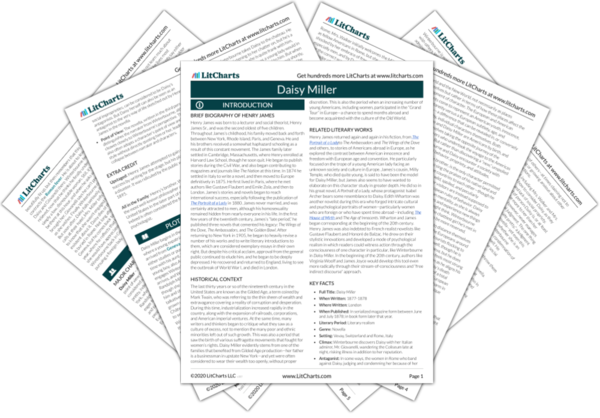Although the beginning of the novella suggests that a romance between Winterbourne and Daisy might supply the rest of the novel, that expectation is thwarted once Winterbourne arrives in Rome and Daisy has taken up with an Italian gentleman, Mr. Giovanelli. Yet even before this, Winterbourne’s relationship with Daisy is one of observation far more than interaction, and this mode of constant observation is tied to Winterbourne’s own inability to embrace his own circumstances and fully live.
Although the narrator seems to be an objective observer, most of the time the narration cleaves to the perspective of Winterbourne, so that what we see of Daisy is through his eyes. Indeed, a number of times in the novella the narrator notes that Winterbourne is watching or looking at Daisy as she interacts with others. Winterbourne’s gaze is that of a regular male admirer, but there is also a certain morbid fascination as he watches her make social mistakes without ever really intervening in more than a half-hearted way. Instead, Winterbourne seems to want to wait to see what Daisy will do next, as if she were a theatrical spectacle unfolding before his eyes. Nowhere is this truer than in the scene at the Coliseum, when Winterbourne catches sight of Daisy with Giovanelli late at night. Even though this is devastating for Daisy’s character (at least in the eyes of others), and even though she will contract the Roman fever here that will ultimately cause her death, Winterbourne feels more than anything a great relief to finally know how to categorize Daisy, exactly what kind of spectacle he is to watch.
Winterbourne’s constant observations of Daisy are purportedly meant to understand her, and even to permit him to win her over—as she seems, to him, to be giving mixed signals regarding her interest. But this search for greater knowledge of Daisy comes at a cost for Winterbourne himself, who seems to lose any kind of motivation on his own other than that of observing Daisy and watching her life unfold. Tied to the woman whose relationship to him remains ambiguous, Winterbourne moves through the novella in a kind of paused state. As the end of the novella strikes much the same note as the beginning—with Winterbourne back to the pursuit of an “older foreign lady”—we come to see the novella as, from his point of view, one long parenthesis that could well have little effect on his later actions and behavior. Unlike Daisy, Winterbourne fails to make choices, even the wrong ones, such that life ends up passing him by.
Observing vs. Living ThemeTracker

Observing vs. Living Quotes in Daisy Miller
[Mrs. Walker] turned her back straight upon Miss Miller, and left her to depart with what grace she might. Winterbourne was standing near the door; he saw it all.
He could not deny to himself that she was going very far indeed. He felt very sorry for her—not exactly that he believed that she had completely lost her head, but because it was painful to hear so much that was pretty and undefended and natural assigned to a vulgar place among the categories of disorder.
He was angry at finding himself reduced to chopping logic about this young lady; he was vexed at his want of instinctive certitude as to how far her eccentricities were generic, national, and how far they were personal.
Winterbourne stopped, with a sort of horror, and it must be added, with a sort of relief. It was as if a sudden illumination had been flashed upon the ambiguity of Daisy’s behavior, and the riddle had become easy to read. She was a young lady whom a gentleman need no longer be at pains to respect.
“She was the most beautiful young lady I ever saw, and the most amiable”; and then he added in a moment, “and she was the most innocent.”
Winterbourne looked at him, and presently repeated his words, “And the most innocent?”
“The most innocent!”
















